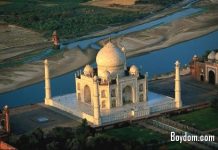India is a hub of mysteries. Its ground is rich with numerous mythologies and folklores. Though the world’s interest in India revolves largely around its colourful culture, but there are some really bone-chilling and dark corners hidden among those colourful hues. Here are 10 More Unsolved Indian Mysteries. For part 1, click here.
10. The Bhootbilli
The Bhootbilli is basically a “ghost cat,” that terrorizes some areas in the city of Pune. It’s a strange amalgamated animal that appears to be a cross between a cat, a dog, and amongoose. One eyewitness claims that the creature is “fat and broad with a long tail, black in colour, has a face like a dog and back like a mongoose”, capable of jumping long distances. ‘Bhutbilli’ is responsible for killing livestock and frightening the locals. Some locals, claiming to have seen it said ‘Bhootbilli’ is “smaller than a lion but bigger than a hyena.” Its existence is largely debatable.
The 1600 Years Old Rust Free Iron Pillar Of Delhi
The Iron Pillar of Delhi is famous throughout India. But one thing that most people don’t know about it is that, it is 99 per cent resistant to corrosion. The 7.21 meters tall structure is as much as 1600 years old and still stands completely rust-free. Made from 98 per cent wrought iron, the pillar has been a subject of varied scientific studies from around the world. While a study concluded that critical corrosion-resistance agent called iron hydrogen phosphate hydrate makes the pillar resistant to rusting. The question that remains that how was such a chemically advanced agent manufactured almost 2000 years ago.
Gyanganj, The City Of Immortal Beings Of The Himalayas
Himalayas have always been linked to mysteries because of its futile terrain and inhabitable climate. But the myth has it that the world’s mightiest mountain range is a home to Gyanganj—a city of immortals and enlightened beings. Ancient Indian and Tibetan tales say that this place is city of mysterious immortal beings that cannot be discovered by ordinary men. It also said that the city is so well camouflaged that no modern mapping technique can identify the place. It is said that it is a place of serenity and ultimate knowledge. Fostering the belief is the famous Indian god-man called Sai Kaka Guru. He once mentioned in a meeting that “I have been to Gyanganj several times over the past half decade.” Many sadhus and mahatmas claim that their arcane knowledge stems from Gyanganj.
7. Super-human Aryans in Himalayas
Heinrich Himmler was a military commander of Nazi Germany. He was one of Adolf Hitler’s key personnel. Himmler strongly believed in occult, magic etc. According to his theory, there existed a race of pure Aryan people in the Himalayas. He believed that they possessed superhuman powers like telepathy. He was so convinced about it that he set out an expedition to Tibet. He formed a team of scientists and set out for Tibet. The main aim of the expedition was scientific study of Tibet’s geology, flora, fauna etc. But according to some journalists, the main aim was to find out and befriend the race of ‘superhuman Aryans’! But no records of the super humans are available. Who knows they really exist or not? Maybe it was just thought up by crazy Himmler. But what if they really exist? What if Himmler kept their existence a secret? The mystery remains unsolved.
Levitating Stone of Shivapur
Legend has it that in a small village near Pune is a levitating stone near the tomb of a certain Qamar Ali. It is said that if the stone is touched by the fingers of 11 people and the name “Qamar Ali Darvesh” chanted, the stone flies up in air. A stone weighing about 200 kg levitating in air is indeed strange. While some believe it to be an illusion, there is no denying that it is a puzzling event and is counted among’st the unsolved mysteries of India.
Existence of Saraswati River
The Saraswati River is one of the chief Rigvedic rivers mentioned in the ancient Sanskrit Texts. Infact several of this Vedic texts and Mahabharata mention the presence of a river carrying enormous volumes of water that eventually dried up in a desert. There have been various studies to determine if such a river indeed existed and the most logical conclusion have been drawn is that perhaps what is the Ghaggar-Hakra River was once the Saraswati. But again there are evidences that suggest that the Saraswati has actually dried up before the the Ghaggar-Hakra river period; raising questions about the authenticity of the existence of Saraswati.
Yeti
Yeti or Abominable Snowman is a mythological humanoid creature said to inhabit the Himalayan region of India and Nepal. The scientific community largely regards the Yeti as a legend, yet it remains one of the most famous creatures of cryptozoology parallel to Bigfoot of North America. It is tall, bipedal creature covered with long white hair and wore no clothes. He had an interesting feature of changing his hair colour in sunlight to fox red. Many expeditions have been organized to track down the elusive Yeti, but none have found more than Yeti footprints and questionable artifacts like scalps and hides. So far there is no firm evidence to support the existence of the Yeti, but there is no way show that he doesn’t exist either. If he indeed lives in the barren, frozen, upper reaches of the Himalayas where few men dare to tread, he may find his refuge safe for a long time to come.
3. Shaking Minarets of Sidi Bashir
In the Sarangpur area of the city of Ahmedabad lies the Sidi Bashir Mosque, also known as “The Shaking Minarets.”
There are many possible stories behind who might have built the mosque; while some say it was Sidi Bashir, a slave of sultan Ahmed Shah, others give credit to Malik Sarang, a noble in the court of Muhammed Begada, another Sultan of Gujarat. In either case, the construction of the mosque was completed in 1452.
What makes the mosque particularly special is that if any person applies a little force or a gentle push on its upper arc, the minaret tends to sway. This phenomenon was first observed by Monsier M. Williams, a 19th century English Sanskrit scholar.
In the quest of getting to the bottom of this mechanism, another Englishman even tried to demolish one of the minarets.
But all his efforts were in vain; there is still a certain mystery surrounding why and how theminarets can sway back and forth. In fact, local engineering students have used the mosque as a case study to investigate the flexibility of construction materials.
Despite its ability to sway back and forth, this mosque perfectly withstands the pressure of trains passing through at one of the city’s main railway stations nearby. It also proved resistant to the 2001 earthquake, which shook the district of Gujarat with a 7.6-7.7 rating on the Richter scale.
In 1981, an electrical failure struck Qutub Minar, the tallest minaret in India. A stampede occurred and 45 people were killed. Ever since, the entry to minarets, and specifically, the possibility to climb to the top of the tower, has been prohibited. The Archeological Survey of India has sealed the entries and one can visit the minaret only with special permission.
Floating Stones – Rameshwaram, Tamil Nadu
Located on Pamban Island, and separated from the Indian mainland by the Pamban Channel, the little town of Rameshwaram has great significance in Hindu mythology. It is from here that Rama is believed to have built a bridge across to Lanka to rescue Sita. Stones used to build this bridge had Rama’s name engraved on them and they never sank in water. The curious fact is that such ‘floating stones’ are still found around Rameshwaram!
Land of Black Magic – Mayong, Assam
A cloak of mystery shrouds Mayong, better known as the Land Of Black Magic, a village 40 kms from Guwahati city, close to Pobitora Wildlife Sanctuary. It is popularly believed that the name Mayong comes from the Sanskrit word for illusion, Maya. Many tales of men disappearing into thin air, people being converted into animals, or beasts being magically tamed, have been associated with Mayong. Sorcery and magic were traditionally practised and passed down over generations. Many ancient relics of Ayurveda and black magic are now preserved in the Mayong Central Museum.









































